The historic town of Sukhothai (meaning "dawn of happiness") with related areas is a UNESCO World Heritage site. Sukhothai was founded in 1238 and was the capital of the first Kingdom of Siam.
Sukhothai Historical Park covers about 70 sq km and the ruins of about 200 temples can be found in the area. The park is divided into five zones and each of the zones has a separate entry ticket. The central zone is the first priority for all tourists as it was the royal part of the city and has most important temples in it. The four other zones (northern, eastern, western and southern) are less touristy than the central zone. The central zone can be easily covered by foot if you are in a decent shape but other zones cover large areas, so cycling around would be a better idea.
If you are going to visit Sukhothai just for one day or if you prefer slow pace of exploration (Sukhothai is perfect for that), the most important temples you should focus on are as follows.
Central Zone
The central zone is protected by a moat and contains 21 temples scattered in the area of 3 sq. km. The zone contains ponds covered with lotus flowers and lots of greenery making it a very picturesque place.
Wat Mahathat
The spiritual focus of Sukhothai city was Wat Mahathat which is the greatest temple not only in the central zone but in all Sukhothai. This royal temple was founded by the first king of Sukhothai and later regularly expanded by successive rulers of the country.
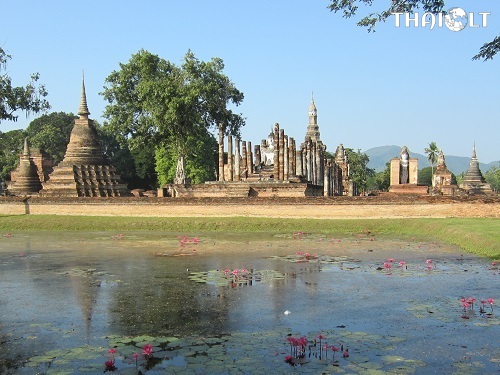
Wat Mahathat contains a lotus bud shaped chedi (stupa), eight smaller stupas (four Lana style stupas and four Khmer style prangs), assembly hall (viharn) with seated Buddha Image and two 9 metre tall standing Buddha images on both sides of the main stupa in mandapas (square buildings).
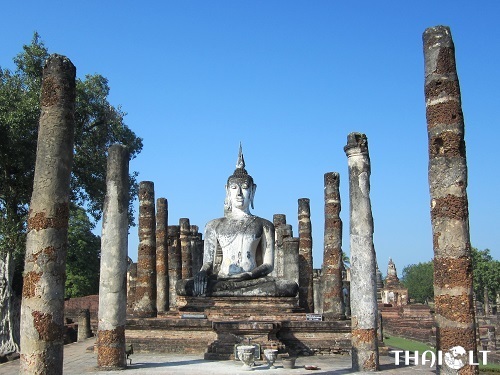
Wat Si Sawai
One of the oldest temples in Sukhothai is Wat Si Sawai, temple located in the central zone, just south of Wat Mahathat. The temple was founded as Hindu Shrine and later adapted into a Buddhist temple.
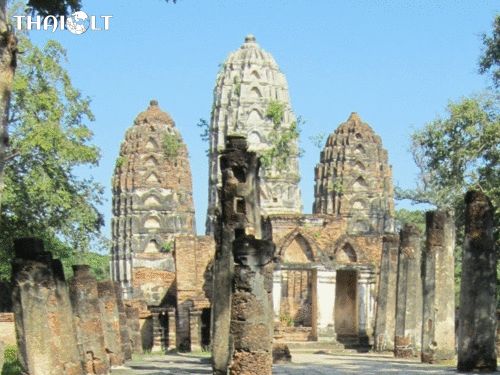
Wat Si Sawai has three well-preserved Khmer style prangs excluding it from all other temples in the park.
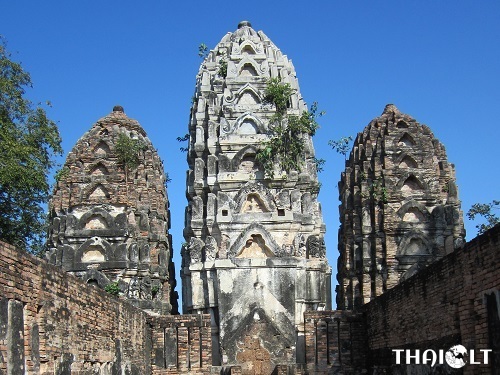
Wat Trapang Ngoen
Another nice temple found in the central zone is Wat Trapang Ngoen, which was built in the 14th century, around the same time with Wat Mahathat. The temple is located just few hundred meters west of Wat Mahathat. Wat Trapang Ngoen means “silver lake temple”. The temple got its name from an artificial lake, named "Trapang Ngoen" (Silver Lake). The ordination hall of the temple was built on a small island in the middle of the lake.
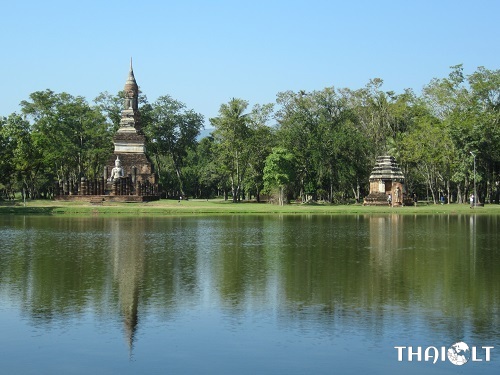
Wat Trapang Ngoen consists of typical Sukhothai style central chedi (stupa) in the form of a closed lotus flower, the ruins of assembly hall (viharn) and a large Buddha image.
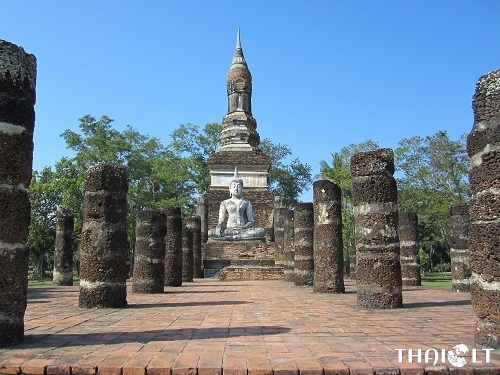
Wat Sa Si
Wat Sa Si is a small temple nicely situated in the middle of the lake just few hundred meters northwest of Wat Mahathat. The temple is one of the most picturesque places in Sukhothai. Wat Sa Si contains a Lanka styled stupa, an assembly hall (viharn) and a ordination hall on its own little island.
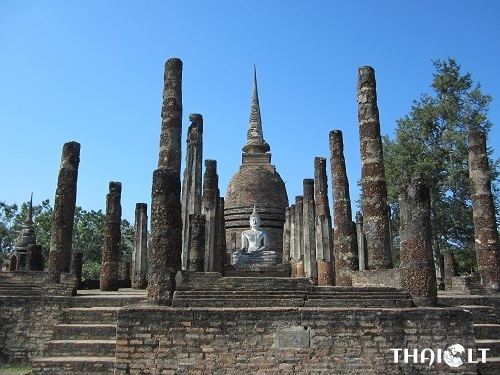
There’s also a very photogenic statue of a Sukhothai style walking Buddha just after entering the premises of the temple.
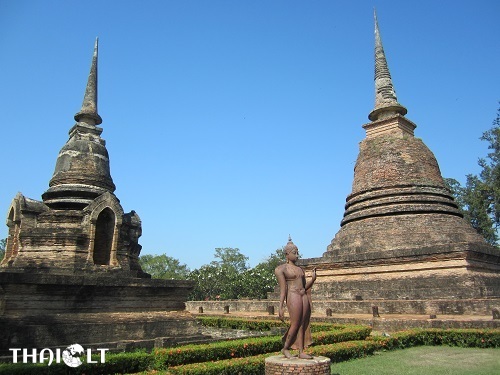
King Ramkamhaeng Monument
King Ramkamhaeng Monument is located in the middle of the central zone of Sukhothai Historical Park. King Ramkamhaeng is regarded as the greatest ruler of Sukhothai even if he wasn’t the founder of it. King Ramkamhaeng is credited with the development of the Thai alphabet and the expansion of Sukhothai kingdom.
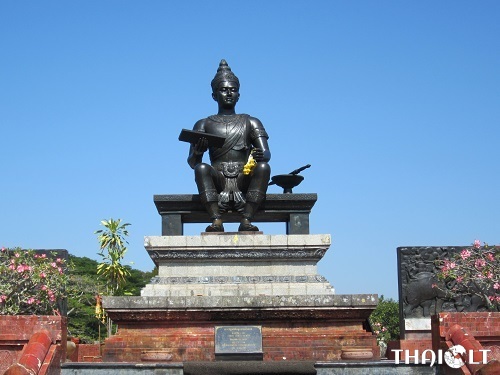
Wat Sorasak
Wat Sorasak is a temple located in the north of the central zone of Sukhothai Historical Park. It is found in a spacious area inside the old walled town and you will likely pass this temple on your way to the temples the northern zone.
Wat Sorasak consists of a chedi (stupa) and an assembly hall (viharn). The bell shaped chedi stands on a brick base surrounded by the bodies of 24 elephants carrying it on their backs.
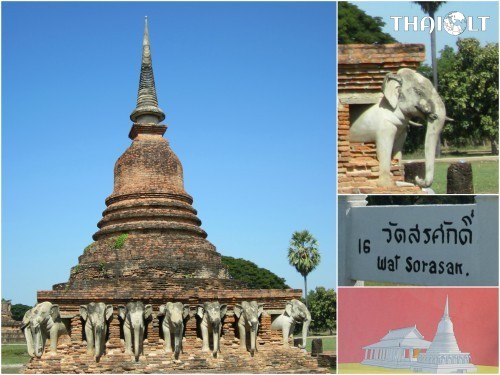
The temple is clearly marked with the name and short description of its history is given (like for most of important temples in Sukhothai Historical Park). The drawings of reconstructed temples are exhibited all around the park too, making it much easier to imagine the greatness of ancient Sukhothai kingdom.
Northern Zone
Wat Phrapai Luang
Wat Phrapai Luang is a big temple complex in the northern zone of Sukhothai Historical Park. Built in the late 12th century when Sukhothai was still under control of Khmer, Wat Phrapai Luang was the ritual center of Sukhothai and the biggest temple in the city area before Wat Mahathat was constructed. Wat Phrapai Luang has three Khmer prangs like Wat Si Sawai but here only one is in good condition. The temple complex is surrounded by double moat.
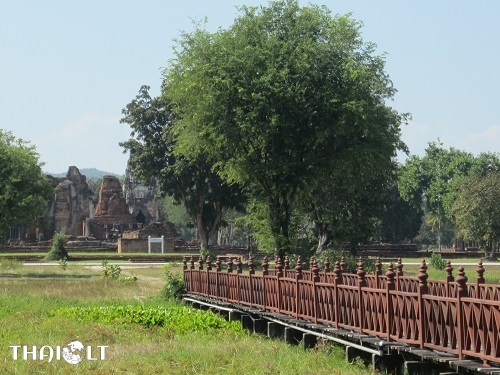
Wat Si Chum
Another impressive temple in the northern zone is Wat Si Chum. The temple complex contains a massive mandapa (square building) and the ruins of assembly hall (viharn) with column fragments and pedestals.
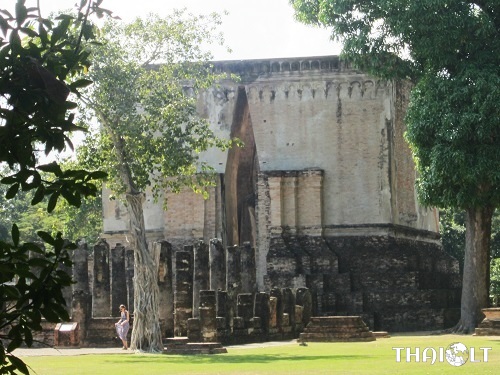
There is a huge seated Buddha image called Phra Achana inside the roofless building. The Phra Achana is the largest Buddha image in Sukhothai measuring 15 meters high and 11 meters wide. This Buddha image can even be partly seen from outside.
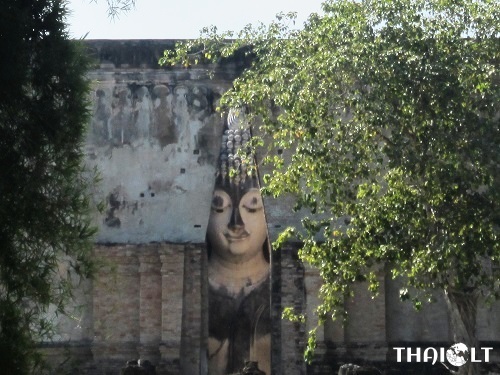
Eastern Zone
Wat Traphang Thong
Wat Traphang Thong is a temple in the eastern zone Old Sukhothai near the road from New Sukhothai. The temple is located on an island in the lake. Wat Traphang Thong got its name from that lake as the name of the temple means “golden lake temple”. Wat Traphang Thong is the only active temple with a community of monks in Sukhothai Historical Park.
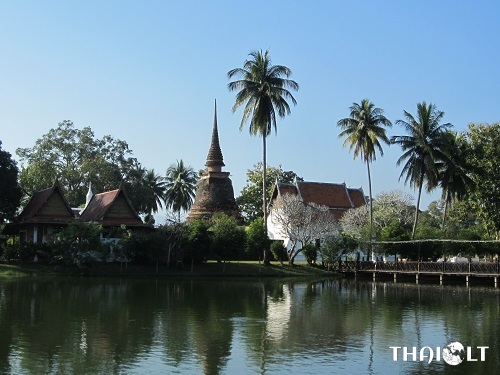
All these temples can be covered by foot in a day but bicycle would a better idea if long walks isn't your thing.
Opening Hours
6am – 6pm daily
Admission
Every zone of Sukhothai Historical Park has a separate entrance fee. Admission to each of the zones is 100 baht plus extra 10 baht for bicycles.
How to get there?
Old Sukhothai Historical Park is about 12 kilometres from New Sukhothai. There are frequent songtaews and few buses (convenient if you are staying near bus station in New Sukhothai) connecting the cities. Or you can just rent a bicycle and cycle all the way to the park and around it.
